 |
||||||
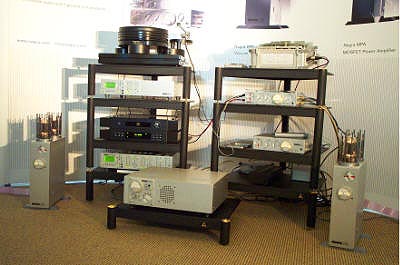 |
Swiss Kudelski Group, Nagra to us flat earthers, hosted the other room that had the Verity Audio Parsefals strut their stuff to perfection. Seeing that Gary Warzin of Audiophile Systems represents both brands as well as Arcam, dCS and Nottingham Analogue, this particular match-up was probably predestined in the higher heavens. The new Nagra DAC 24/192 2-channel Sound Processor (center) uses the same remote as the PL-L and MPA and controls selection of the 7 inputs as well as volume/balance. Comprehensive display adjustments include brightness/dim as well as color of display bars. Sparse on hard tech data, the preliminary spec sheet merely whets our whistle but does mention the option of floating the outputs via high-quality Nagra output transformers. Ditto for the Nagra DAP Digital Audio Processor. It's a 24/192 upsampling DAC/processor for "High-End and Home Theater purists" whose basic 5.1 format can be expanded to 7.1. Using the same chassis, the DAP adds 3 front panel displays for viewing/adjusting the rear, center and L.F.E. channels respectively. Like the DAC, decoding is compliments of Swiss firm Anagram whose advanced digital conversion technology is also licensed to Orpheus Labs, Audio Aero, AudioMecca, Talk Audio and a growing number of other peak-performance digital audio products. The only other data of note gleaned from the prelim handout? All coaxial outputs are duplicated by XLR terminals. As their fellow-Schweitzer from Ensemble had already demonstrated, this Nagra room established the same milieu of aural class and elegance. 'Twas quite the far cry from the kind of sterile metronome precision one might instinctively associate with products from the land of bespoke timekeeping devices. Add top-shelf customer service as evinced by Swiss representative Mrs. Aldona Mury. She resolutely and effectively untangled a Gordian knot of internal miscommunication for my friend in one felt swoop. She personally followed up within days after the show just as promised. The word class act springs to mind. To do as you said you would (or die trying) is such a basic rule of honorable conduct! Yet, so few truly live by it. Herzlichen Dank, Aldona! The Odeon No. 32 is a third-generation 3-way modular hornspeaker that tops out the firm's new 5-model Series 2001 line-up with a 20-cm spherical wooden horn loading a Zoll tweeter while a larger 48-cm horn loads the 13-cm HDA cone mid. Bass duties are performed by a 32-cm paper cone woofer. For further specs, contact US distributor AXISS. Globe Audio Marketing hosted the Orpheus Laboratories exhibit, another Swiss firm entering the High-End circus tent with high-wire gusto. They too employ Anagram digital technologies but categorically eschew the glowing glass bottles Audio Aero adds to all their products. Slim single rack-space packaging hints at a professional background. The Orpheus One ($4,800, +$1,560 for each additional 2-channel board for up to 3 add-ons) is a 2 to 8-channel 24/192 resampling DAC; the Orpheus Two ($6,720) an analog multi-channel remote-controlled preamp with digital volume control that can operate two independent multi-channel systems; while the Orpheus Three ($4,600/8,400) is a 40/150-watt stereo/mono power amp. The speakers shown were by StudioLAB, a line consisting of four models, the Reference One thru Three and the displayed Revelation which, despite its regular dimensions, weighs in at a back-breaking 170 lbs each. With cabinet walls up to 3 inches thick, extreme inertness seems to be the name of the game here. Twin 7-inch Scanspeak Revelators surround an offset 1.1" Revelator tweeter for a claimed frequency response of 29-22,000Hz while the externally mounted crossover uses Hovland Musicaps, Alpha-Core coils and Cardas wiring/posts to eliminate the typical signal path redundancy between network and terminals. |
|||||
 |
||||||
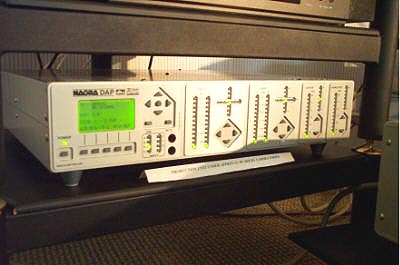 |
||||||
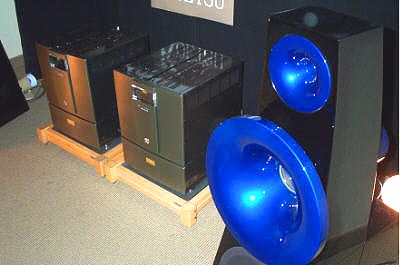 |
||||||
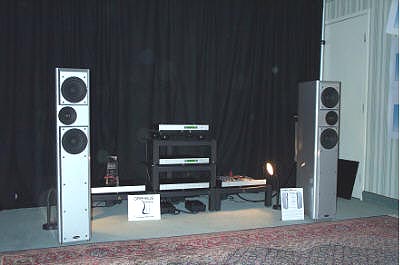 |
||||||
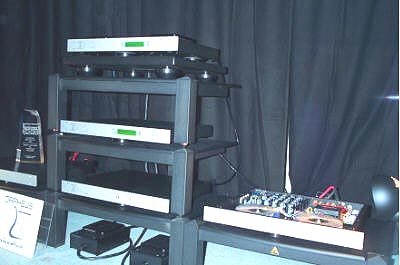 |
||||||
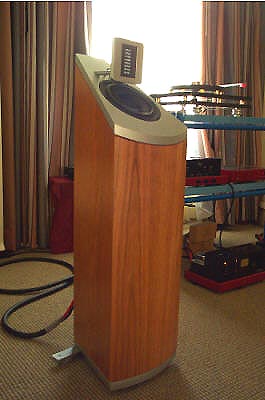 |
 |
|||||
| Vince Scalcitti of Tri-Cell Enterprises, years ago while I still worked for Pat McGinty, had the good taste to become the distributor for Meadowlark Audio into Canada. His latest stable addition is the Oskar A.V.T Air Velocity Transformer speaker line from the also-Swiss Precide SA who collaborated with TELOS Berlin on the industrial design and Mieko Duerrenmatt on the sonics. Previous models include the Kithara ($4,200) and Aulos (2,000) models between which now slots the new Syrinx ($3,100) in Maple, Cherry or Black. Its direct-radiating tweeter / ambient upfiring 43-degree angled woofer array reminded me conceptually of Dick Olsher's Samadhi efforts. The Syrinx cast one of those gargantuan airy omni-stages but the tweeter's deliberate directivity replaced the somewhat nebulous focus of true omnis to here give natural image specificity. Readers remembering the JecklinFloat headphones of yore are advised that the same Precide firm in Switzerland still makes/markets that Ergo brand. Fleeing my devilish German charm for the other room, pARTicular's Volkar Druebbisch had his wife Anne-Lousie pose next to his latest stand addition which, instead of standard platforms, uses casings to hide component side panels that Volkmar doesn't care to look at. The hang-gliding San Fransciscan finally succumbed to the call of the country. He splurged on an 80-acre spread 3 hours inland from the metropolis, with a bare house, cold running water, a new German shepherd and a transplated shop evidence that he finally will leave his beloved city after all. Congratulations, Volkmar, for being one of the pioneers of the "stands make an audible difference, goddamit" mantra and hanging in there long enough to make a successful business. I shall visit and check out your new haunt once the water heater is installed. Best of luck! |
||||||
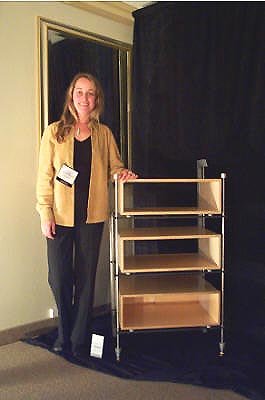 |
||||||
 |
||||||
 |
||||||
No other speaker is held in as high an esteem as the original Quad for what it did right - the all-important midrange. Globe Audio Marketing sells the complete Quad Classic line through a process dubbed "serial refurbishing". Scouring the globe for original Quad equipment, they wait until they've gathered a suitable number to begin the rebuilding process in fully matched pairs. |
||||||
Available models include the ESL 57 ($6,500), the ESL 63 ($7,500), the Braun LE-1 Bauhaus design ($7,140), the original KT-66 design 15w triode Quad II mono amps ($4,930) and the Quad 22 linestage ($1,360). It also offers complete refurbishing/replacement parts services to current owners. Displayed in the pix is a classically "stacked array". While I did enjoy their tube/vinyl/Quad-midrange presentation, the adrenaline junkie in me lusted to go back home and listen to my turbo-charged Avantgarde DUOs instead. I need more visceral excitement and dynamics than the Quads, bless their hearts, are capable of. But if you're an old -- or young -- geezer (just kidding!), this type of sound may be up your elevator. |
||||||
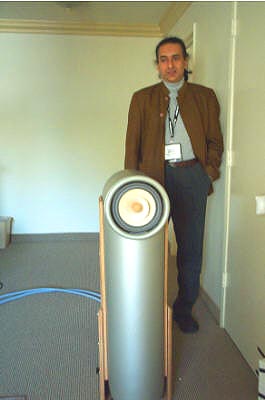 |
The third single-driver demo that caused me to unbuckle my helmet, discard the leathers and take up way too much time in one single room was the Second Rethm demo. Not a new product per se, it nonetheless was my first encounter with it. Using the DX4 Lowther driver in a very trick enclosure, claimed response is 45-22,000Hz. Rethm translates as harmony from Sanskrit. And damn it if this very simple system didn't transport me to heaven and back. Partial blame for this shameful excursion must go to Richard Seah's Tian Zhu amplifier of Diva which, just like the complete Shigaraki system, just arrived today and seems to translate as "Voice from Heaven". With the speakers spread apart as far as room width would allow while still -- very carefully -- entering through the door; and having them midway into the room for that endless depth such a setup guarantees - I wasn't counting violins, crossover or minus 3dB down points but simply responding to the emotive force of -- okay, okay, my own -- music. But that's really the trick, isn't it? If you bring music that tickles your cochlea at home in that come-hither sneak-under-your-skin way and it doesn't do it elsewhere - well, something is amiss. Needless to say, Rethm, Konus Audio and Cain & Cain each get my personal Namaste for communicating -- in their own singular let-thine-eye-be-one but equally compelling ways -- the raw force of music to my hungry heart. As an aside, this was the first Lowther design that got to me. All others I've encountered previously were too riddled with obvious limitations as to not taint their very real midrange immediacy virtues with flaws I couldn't live with. |
|||||
The new Zeus ($6,000) by Rogue Audio appears like a hot'n'hunky armful of amp for the money asked. The way it handled the already mentioned brutalizing of the Blue Heron2s during a late-hour decibel climax in the Meadowlark Audio room proved that bass control, grip and drive are not the sole providence of the sandpeople. Add that designer Mark O'Brian is one of the good guys in audio and it seems that offering 170/250 watts of triode/ultra-linear go juice is perhaps not as bad as my flee-brained 6-watt allegiances might have you believe? Gotcha. I really don't care how you get to the pearly gates as long as you get there. Chip Stern over at Stereophile gloated over having one of these beasts coming to him post haste just today. So keep your bias adjusted to what my favorite NY cabbie (ex-cabbie, but he has 1001 hilariously colorful stories to tell about those years now long past) will have to report once the current backlog of 'phile reviews clears the pipeline. Also watch for Chip's forthcoming review on the Manley Massive Passive in these very pages. |
||||||
 |
||||||
| Since Stephaen joined us already in a 4-6 times a year fashion, Chip will become our third contributor. More claim to be gathering wind in the wings but only well-seasoned colorful characters with straight rifles and good target practice may apply. Not to worry: 6moons will remain about quality-but-fun writing with a distinct bend/twist. No passion, no entrance to our small but growing stable. I already did thank you, dear reader, for your patronage in my Year 2003 address. But I'll do it again. Without you, none of us would be doing this. The more of you there are, the more worthwhile you make it for us. So pass it around, would ya? |
||||||
 |
||||||
 |
||||||
 |
||||||